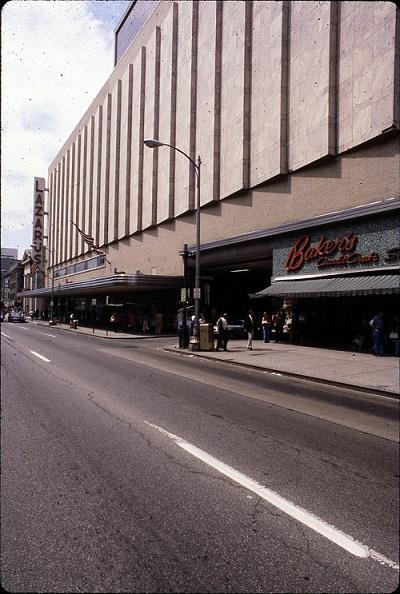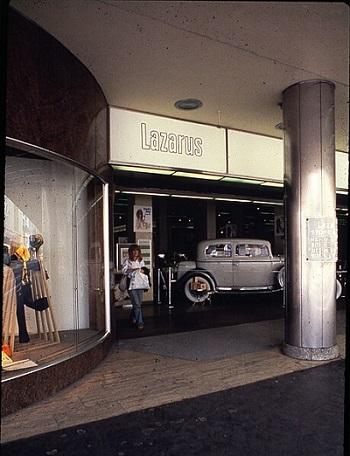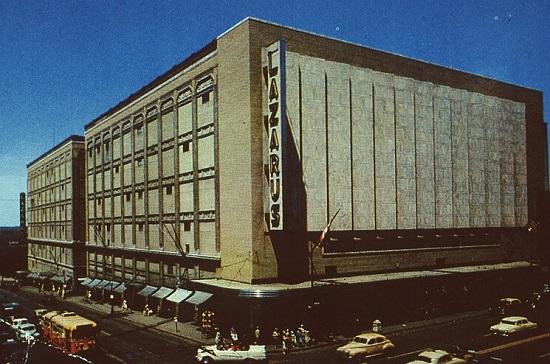The Rise and Fall of the Lazarus Department Store: An Enduring Legacy of Shaping the Quintessential American Shopping Experience
The name Lazarus vividly evokes memories of a bygone era of retail, when department stores were the epicenter of community life and shopping was a cherished experience eagerly awaited all year. For over 150 years, generations of customers walked through Lazarus’ revolving doors to discover a shopping paradise brimming with values, traditions, and innovations that laid the foundation of the modern American shopping landscape. From its 1851 birth as a fledgling Columbus clothier to its closure amidst 21st century consolidation, the Lazarus story intricately mirrors the trajectory of retail itself. While the company ultimately fell victim to changing consumer habits, Lazarus indelibly shaped the retail industry and created the archetypal shopping experience that still resonates with customers today.
A Brief List of Retail Innovations Pioneered by Lazarus
- One-Price Policy: Lazarus broke the mold by offering fixed-price items, ditching the old haggle-and-hassle approach. Walk in, see the price, no surprises.
- First Escalator in a U.S. Department Store: Before moving walkways were a thing, Lazarus installed America’s first department store escalator, setting a new standard for shopper convenience.
- Introduction of the Bargain Basement: Lazarus gave birth to the Bargain Basement, a space dedicated to discounted items. It was like striking gold, but for shoppers on a budget.
- 1918: The Good-Health Store of Columbus: In the midst of the influenza pandemic, Lazarus rebranded itself as a hub of health, boasting a ventilation system that cycled in fresh air every four minutes.
- 1929: Formation of Federated Department Stores: Lazarus teamed up with the likes of Bloomingdale’s and Filene’s, creating Federated Department Stores.
- No-Money-Down Credit: Federated broke new ground by offering no-money-down credit.
- 1934: A Cool Shopping Experience: Summer shopping got a whole lot cooler when Lazarus introduced air conditioning. They beat the heat before it was even a thing.
- 1939: Extending the Holiday Shopping Season: Fred Lazarus Jr., wanted to make the holiday shopping season even merrier. He persuaded Congress to move Thanksgiving to the fourth Thursday in November, adding more days to the shopping calendar.
Humble Origins on the Ohio Frontier
The Lazarus saga began in 1851 when German immigrant Simon Lazarus opened a modest 20 x 50 foot men’s tailoring shop on the dusty thoroughfare of High Street in the frontier town of Columbus, Ohio. With the state capital boasting just 17,882 residents, Columbus remained a provincial cow town, but the seeds of Lazarus’ retail revolution were already being planted.
Simon Lazarus started his entrepreneurial venture with scant capital of $3,000 and just a single clerk in his employ. Living frugally above the store with his family, Lazarus slept on a cot to personally safeguard his merchandise. His shop occupied a prime spot on High Street, positioned on the key watershed dividing the Scioto River and Alum Creek. This strategic location on the community’s main street would fuel Lazarus’ rise.
Guided by Germanic thriftiness, honesty, and industriousness, Simon Lazarus built his business on providing quality wares, personalized service, and representing customers’ interests in transactions. This “Golden Rule” philosophy engendered deep trust that attracted a devoted clientele, cementing Lazarus’ sterling reputation as “the square dealing clothier.” As Lazarus proclaimed in an early advertisement, “No Misrepresentation! No Deception! No Overcharge!” This core value proposition established the foundation for Lazarus’ future success.
Generational Growth and Prosperity
Lazarus quickly emerged as a Columbus staple, its growth paralleling the city’s increasing prominence. As Columbus evolved into a bustling capital and commercial crossroads, Lazarus’ sales expanded. Simon’s sons Fred and Ralph Lazarus joined the enterprise, ushering in decades of family management that shaped the company’s ethos. The brothers personally connected with regulars as lifelong customers became like family. During the Civil War, that familiarity even prompted the brazen teenage duo to march into Camp Chase and demand Confederate raiders return stolen Lazarus goods, recouping the loss.
By 1877, two floors were added to accommodate swelling sales. Amelia Lazarus, Simon’s wife, shared ownership with Fred and Ralph following her husband’s passing. Under their leadership, Lazarus bloomed to become the city’s largest store and leading clothier across central Ohio. In 1888, 22 employees staffed Lazarus, spotlighting its growth.
As Columbus approached the dawn of a new century, Lazarus strategically pivoted to cement its dominance. In 1909, the company moved into a six-story edifice specially constructed on High Street. This grand emporium expanded merchandise beyond men’s apparel to the burgeoning women’s market. Offering “everything ready to wear,” Lazarus was reborn as a pioneering department store.
Once derided as “overbuilt,” the capacious new store quickly filled sales floors added in 1911, 1914, and 1917. By 1920, Lazarus boasted 20 departments with a bustling basement bargain bazaar. Sales nearly doubled within a decade after huge crowds flocked to the new destination. Centrally located with modern amenities and attentive service, Lazarus became a gathering spot to see and be seen.
Transforming Shopping from Dreaded Chore to Leisurely Pleasure
Lazarus understood a satisfying customer experience created loyal shoppers. While competitors viewed stores as no frills warehouses for distributing merchandise, Lazarus lavished care in shaping an enjoyable retail adventure. Every aspect of the shopping experience was deliberately orchestrated to uplift customers.
Before Lazarus, buying was a tedious chore involving crowds and haggling. Stores lacked comforts, so women dreaded the required excursions. Seeking to Shift shoppers’ attitudes, Lazarus introduced innovations focused on simplicity, ease and entertainment. It pioneered the revolutionary one-price policy to eliminate haggling’s hassle. Customers marveled at novel technologies like store escalators, telephones, and air conditioning that made shopping effortless. Cooking shows, fashion displays, and holiday events injected entertainment. Attentive elevator operators whisked shoppers directly to desired floors. Affordable credit programs enabled aspirational spending. Thoughtful perks like check cashing, receptionists, free deliveries, and altered garments cemented Lazarus’ reputation for service. Stores were immaculately maintained to create an atmosphere of abundance and quality. Shopping became a welcoming experience savored at a leisurely pace, not an inconvenient necessity rushed through. Lazarus taught retailers that selling was secondary to encouraging customers to linger.
Cultivating Holiday Traditions and Memories
Lazarus also pioneered transforming shopping into a nostalgic tradition fervently anticipated year after year. Its lavish Christmas window displays transporting spectators into holiday fantasies became a beloved local ritual attracting throngs. Yuletide decorations transforming stores into winter wonderlands stirred excitement for Santa’s coming visit. The innovative “Secret Gift Shop” allowing children to independently buy presents was a rite of passage teaching the spirit of giving. Sing-alongs with animated characters and visits from Santa Claus himself created joyful memories passed between generations. Shopping at Lazarus became an essential part of central Ohio families’ holiday customs.
For over a century, Lazarus’ Thanksgiving Day Parade was the official kickoff to the Christmas season. When the fourth Thursday of November 1939 fell on the 30th, Fred Lazarus Jr. successfully lobbied Franklin Roosevelt to permanently designate Thanksgiving as the fourth Thursday. This created a standardized longer shopping season, benefitting customers and retailers. Lazarus magnified Christmas’ commercial tones but balanced it with charming traditions binding community.
An Architectural Legacy Standing the Test of Time
As Lazarus expanded, its flagship location remained an iconic downtown Columbus landmark. Patrons marveled at the imposing edifice with lavish windows attracting sidewalk admirers. The building’s Beaux-Arts architecture presented Lazarus as a cultured institution and temple of commerce. Extensions were completed in 1921 and 1927 to accommodate the store’s ballooning popularity.

Photograph looking southwest of the Downtown Columbus Lazarus Department Store, 141 South High Street. Also seen is the sign for Baker’s QualiCraft Shoes, 123 South High Street. Baker’s was located in the Lazarus building for more than 25 years before closing in 1988.
When Lazarus shuttered in 2004, uncertainty clouded the historic building’s fate. Some advocated razing it for modern development. Preservation ultimately triumphed. The rechristened Lazarus Building was redeveloped into a mixed-use space housing offices, shops and a public garden. Repurposed but still dominating the skyline, the restored structure stands as a tribute to Lazarus’ legacy.

Photograph of a woman walking out of the South High Street entrance to the Downtown Columbus Lazarus Department Store, 141 South High Street. A classic automobile is on display just inside the entrance.
Suburban Sprawl Sows the Seeds of Decline
After a century as Columbus’ predominant retailer, the post-war years saw Lazarus face its first true competition. Suburbanization expanded outside traditional downtowns as road networks spread. Rural farmland was transformed into suburban subdivisions, shifting residential patterns. Customers migrated to Lazarus branches in suburban malls offering convenience and free parking.
The 1960s brought the rise of discount retailers promising even lower prices. Chains like Kmart, Walmart, and Target offered bargain merchandise in no-frills environments compared to department stores’ higher prices. Shrinking profit margins forced Lazarus to reduce labor-intensive services. As convenience and cost trumped experiences, Lazarus struggled to adapt its model. Attempts to launch its own discount brand Gold Circle ultimately eroded full-price sales. While Lazarus branches spread statewide, challenges mounted in its core Columbus market.
Acquisition and Decline of a Retail Giant
Despite difficulties, Lazarus’ size still increased through acquisitions. It became the cornerstone of Federated Department Stores, a conglomerate eventually comprising over 400 stores under regional banners. Lazarus merged with fellow Federated chains Shillito’s and Rike’s, consolidating to cut costs. While this created a Midwestern retail behemoth, Lazarus’ identity was diluted. After over 150 years of family management ended, critics accused Federated of neglecting Lazarus.
By the 1990s, Lazarus faced extinction amidst retail’s turbulence. Mainstream department stores languished as specialized big-box category killers swarming suburban shopping malls stole market share. Consolidation was rampant as retail giants gobbled up competitors. Federated absorbed faltering chains, then rebranded its stores under just two national banners—Macy’s and Bloomingdale’s. This strategy spelled the end of regional identities. Despite protests, Lazarus was rebranded as Lazarus-Macy’s in 2003 before converting fully to Macy’s in 2005. Columbus’ beloved hometown institution faded into history.
Enduring Legacy: Shaping the Quintessential Shopping Experience
Although the Lazarus name disappeared, the company’s imprint on retail remains indelible. It created the template for the ideal shopping excursion that consumers still seek today. Lazarus proved stores could be more than just salesrooms by skillfully blending merchandise, entertainment, hospitality, and heritage. It manufactured treasured memories that became meaningful lifetime traditions. This potent cocktail remains the gold standard that modern retailers aim to recreate.
Myriad Lazarus innovations pioneered practices that are now retail fundamentals. Ideas like fixed pricing, liberal credit, escalators, centralized checkout, and magnified holiday marketing originated with Lazarus. Its model department store was emulated nationally. Lazarus demonstrated retail’s power to positively influence communities, not just sell goods.
The company’s ability to emotionally engage customers was remarkable. Scores fondly reminisce about childhood trips to Lazarus’ magical toy department or their first credit card signaling adulthood. Pining old patrons still congregate in Lazarus-centric online communities to reminisce. This reveals the heights retailers can reach when they sell experiences, not just products.
Today’s retailers follow Lazarus’ example pursuing experiential shopping integrating entertainment, technology, customization, and services. They amplify holidays’ commercialism but balance it with cheer. Everything from modern department stores to mall Santas to Elf on the Shelf trace back to Lazarus’ innovations. The beloved shopping experiences Lazarus pioneered over a century ago remain the nostalgic pinnacle today’s merchants endeavor to recreate. That enduring impact cements Lazarus’ legacy as the progenitor of the archetypal American shopping experience.
Sources:
- Columbus Dispatch: Columbus’ Lazarus department store was retail pioneer
- Wikipedia: Lazarus Building
- Bees First Appearance: Look to Lazarus, Columbus Shoppers, and Start Reminiscing
- Wikipedia: Lazarus (department store)
- Columbus Monthly: From the Archives: The End of the Lazarus Dynasty
- Columbus Downtown Development Corp: Lazarus Building
- Lazarus Building Exterior Image 1 (from street)
- Lazarus Building Exterior Image 2 (entrance)










